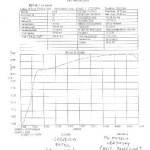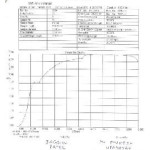A. K. Srivastava1, M. K. Prajapati1, Jagdish Patel1 and Rajesh Srivastava2
¹Dr. C.V. Raman University, Kota, Bilaspur (India).
²LCIT, Bilaspur (India).
Article Publishing History
Article Received on : 25 Marc 2012
Article Accepted on : 13 May 2012
Article Published :
Article Metrics
ABSTRACT:
In the present paper theoretical as well as practical investigation has been carried out to evaluate the compression and tensile of some practical material. The testing is performed by universal Testing Machine (UTM). UTM is used to test the tensile stress and compressive strength of materials. It is named after the fact that it can perform many standard tensile and compression tests on materials, components and strictures. The requirements for tensile and compression strength values and the methods for testing these properties are specified in various standards for a wide variety of materials. Testing can be performed on machined material samples or on full size or scale models of actual component. It is found that stress initially increases against strain and then decreases. Further it is observed that displacement increase with increasing time for 12:00 mm sample diameter. The variation of stress abruptly increases with increasing strain and displacement slowly increases and after fixed point displacement abruptly increases.
KEYWORDS:
Tensile; Practical Material
Copy the following to cite this article:
Srivastava A. K, Prajapati M. K, Patel J, Srivastava R. An Estimation of Compression and Tensile of some Practical Material. Mat.Sci.Res.India;9(1)
|
Copy the following to cite this URL:
Srivastava A. K, Prajapati M. K, Patel J, Srivastava R. An Estimation of Compression and Tensile of some Practical Material. Mat.Sci.Res.India;9(1). Available from: http://www.materialsciencejournal.org/?p=1168
|
Introduction
In material science, the strength of a material is its ability to withstand an applied stress without failure, the applied stress may be tensile, compressive, or shear. A load applied to a mechanical member will induce internal forces within the member called stresses. Those stresses acting on the material cause deformations of the material. Deformation of the material is called strain, while the intensity of internal forces are called stress. The strength of any material relies on three different type of analytical method : strength, stiffness and stability. Where strength refers to the load carrying capacity. Stiffness refers to the deformation or elongation and stability means refers to the ability to maintain is initial configuration. The ultimate strength refers to the point on the engineering stress – strain curve corresponding to the stress that produces fracture. A material’s strength is dependent on its microstructure. In the present work it has been given attention on estimation of tensile and compression same practical material. The testing is performed by Universal Testing Machine (UTM). It is named after the fact that it can perform many standard tensile and compression tests on
materials, components and structures. The UTM has following components –
- Load Frame
- Load Cell
- Cross head
- Means of measuring extension
- Output devices
Tests fixtures, specimen holding waves and related sample making equipment are called for in many test methods.
The evaluation of the mechanical behaviors of a sample under conditions of tension and compression can be performed to provide basic material property data that is critical for component design and service performance assessment. The requirements for tensile and compression strength values and the methods for testing these properties ore specified in various standards for a wide variety of materials. Testing can be performed on machined material samples or on full size or scale models of actual components. In this research work different samples have been used and result also is obtained in the form of graphs.
Theoretical considerations
A tensile test in a method for determining behavior of materials under axial tensile loading. The tests are conducted by featuring the specimen into the test apparatus and them applying a force to the specimen by separating the testing machine crossheads. The crosshead speed can be varied to control the rate of strain in the test specimen. By the automatic result it is found the result in the form of graphs. All features such as, Ref.No., Party Code No., Test No., Sample No., Sample name, Sample
length, Sample diameter, final diameter, original gauge length, ultimate load, break load, cross section area, Reduction area, ultimate tensile strength, Yield load, B. Sirth, Yield strength, elongation, final gauge length, Temperature, Humidity etc are obtained by automatically.
The evolution of the mechanical behaviors of sample under conditions of tension and compression can be performed to provide basic material property data that is critical for component design and service performance assessment. A tensile test in a method for determining behavior of materials under axile tensile loading. The test are conducted by fixturing the specimen into the lest apparatus and then applying a force to the specimen by separating the testing machine crossheads. The crosshead speed can be varied to control the rate of strain in the test specimen. Tensile tests can be perform on many materials, including methods, plastics, fibres, adhesives and rubbers.
Figure 1
Figure 2
Results and Discussion
In Fig.(1) it is seen that the stress and strain of sample diameter 12:00 is 619.25 N/sq. mm and 0.528 respectively. At the point of 0.49 stress and 0.053 strain the shape in changed. Following result is obtained –
Final diameter : 20.00 mm
Original Gauge length : 100:00 mm
Ult. Load : 70.00 KN
Break Load : 64.10 KN
Cross section area : 113.04 sq.mm
Reduction area : 177.78%
Ultimate Tensile Strength : 619.25 N/sq.mm
Yield Load : 54.60 KN
Elongation : 10.00%
Final Gauge Length : 110.00mm
Temperature : 230C
Humidity : 26.00 RH
In Fig. 2, it is observed the stress and strain of sample 3, diameter 25mm is 656.71 N/sq.mm and 0.960 respectively. At the point 0.66 Stress and 0.864 Strain the shape is changed. Further following result is obtained –
Final Diameter : 25.00mm
Original Gauge Length : 100.00mm
Ult. Load : 322.20 KN
Break Load : 288.80 KN
Cross section area : 490.62 sq.mm
Reduction area : 36.00%
Ultimate Tensile Strength : 656.71 N/sq.mm
Yield Load : 198.99 KN
Elongation : 10.00%
Final Gauge Length : 110.00mm
Temperature : 230C
Humidity : 26.00 RH
References
- Callister W.D., “ Material Science and Engineering an Introduction, John Wiley & Sons, USA, ISBN No. : 0-471-22471-5 (2003)
- Groober MIkell, “ Fundamentals of Modern Manufacturing” , John wiley & Sons, USA (2002).
- Khurani R.S., “ Strength of Material” S. Chand & Company Ltd. (2006).
- Rajput R.K., “ A Text Book of Material Science and Engineering, S.K. Kataria & Sons, Delhi (2006-07).
- Singh Sadhu,Strength of Material ,Khanna Publishers, Delhi (2007).
- Tripathi Sukanta k. , Padhy Arun K. & Panda Achut K. ,” Material science & Engineering” , Scitech Publication (India)

This work is licensed under a Creative Commons Attribution 4.0 International License.
 Material Science Research India An International Peer Reviewed Research Journal
Material Science Research India An International Peer Reviewed Research Journal




